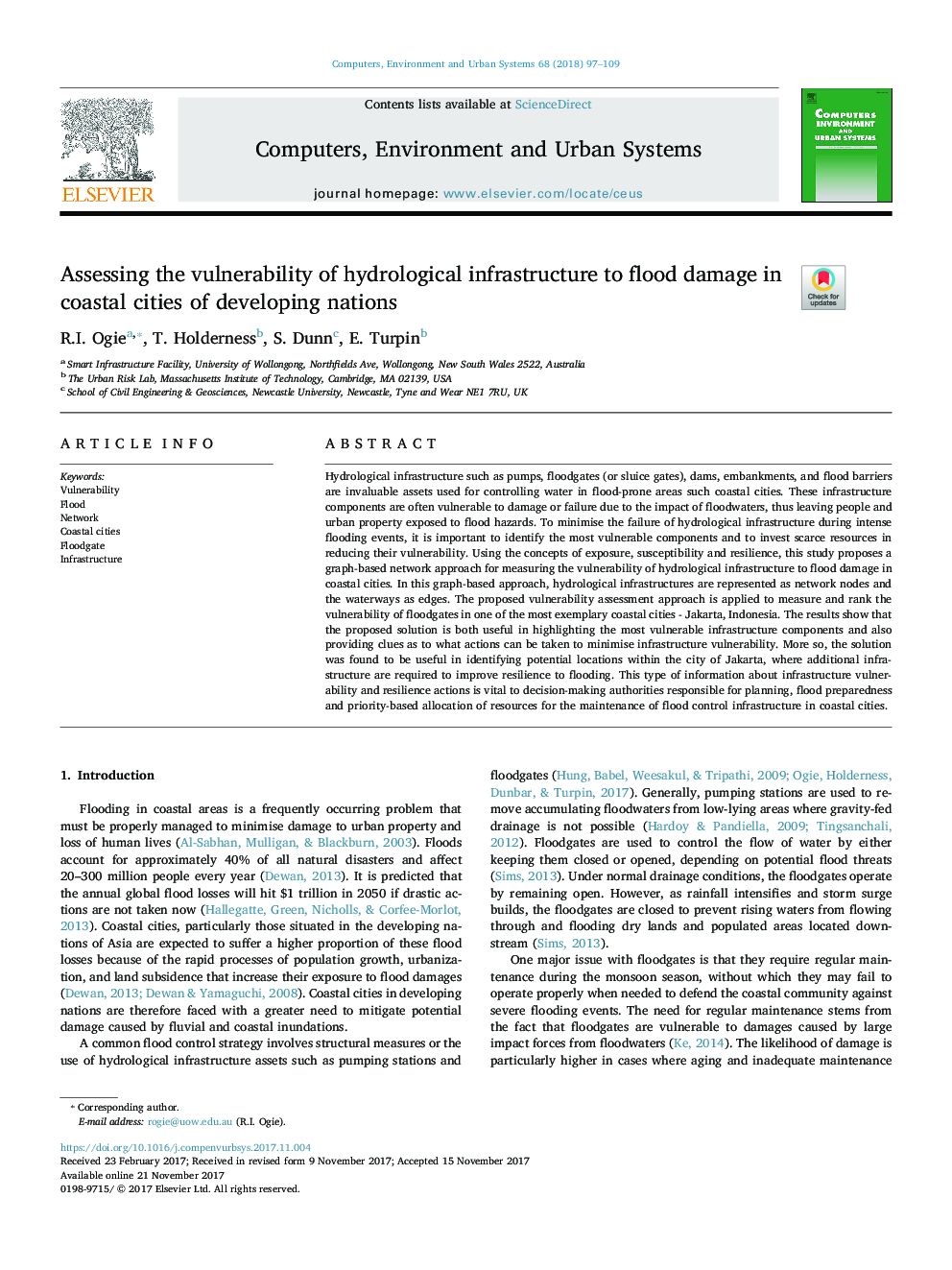| کد مقاله | کد نشریه | سال انتشار | مقاله انگلیسی | نسخه تمام متن |
|---|---|---|---|---|
| 6921873 | 1448222 | 2018 | 13 صفحه PDF | دانلود رایگان |
عنوان انگلیسی مقاله ISI
Assessing the vulnerability of hydrological infrastructure to flood damage in coastal cities of developing nations
ترجمه فارسی عنوان
ارزیابی آسیب پذیری زیرساخت های هیدرولوژیکی برای آسیب های سیل در شهرهای ساحلی کشورهای در حال توسعه
دانلود مقاله + سفارش ترجمه
دانلود مقاله ISI انگلیسی
رایگان برای ایرانیان
کلمات کلیدی
ترجمه چکیده
زیرساخت های هیدرولوژیکی مانند پمپ ها، سیلاب ها (یا دروازه های شلنگ)، سدها، کف زمین ها و موانع سیل، دارایی های ارزشمندی هستند که برای کنترل آب در مناطق سیلاب مانند شهرهای ساحلی مورد استفاده قرار می گیرند. این قطعات زیربنایی اغلب به آسیب و یا شکست به دلیل تاثیر سیلاب ها آسیب پذیر است، بنابراین مردم و اموال شهری در معرض خطر سیل قرار می گیرند. برای به حداقل رساندن شکست زیرساخت های هیدرولوژیکی در حوادث شدید سیل، شناسایی اجزای آسیب پذیر ترین و منابع کمیاب در کاهش آسیب پذیری آنها مهم است. با استفاده از مفاهیم مواجهه، حساسیت و انعطاف پذیری، این مطالعه یک رویکرد شبکه مبتنی بر گراف برای اندازه گیری آسیب پذیری زیرساخت های هیدرولوژیکی برای آسیب های سیلابی در شهرهای ساحلی را پیشنهاد می دهد. در این رویکرد مبتنی بر گراف، زیرساخت های هیدرولوژیکی به عنوان گره های شبکه و آبراه ها به عنوان لبه ها ارائه شده است. رویکرد ارزیابی آسیب پذیری مورد استفاده برای اندازه گیری و رتبه بندی آسیب پذیری سیلاب ها در یکی از نمونه هایی از شهرهای ساحلی - جاکارتا، اندونزی است. نتایج نشان می دهد که راه حل پیشنهادی هر دو در برجسته کردن اجزای زیرساختی آسیب پذیر ترین و همچنین ارائه سرنخ هایی در مورد اقداماتی که می تواند برای آسیب پذیری زیرساخت ها به حداقل برسد، مفید است. به همین ترتیب، این راه حل در شناسایی مکان های بالقوه در شهر جاکارتا، که در آن نیاز به زیرساخت های اضافی برای ارتقاء قابلیت انعطاف پذیری در برابر سیل، مفید است، مفید خواهد بود. این نوع از اطلاعات مربوط به آسیب پذیری و اقدامات انعطاف پذیری زیربنایی برای مقامات تصمیم گیری مسئول برنامه ریزی، آمادگی سیل و تخصیص منابع بر اساس اولویت برای نگهداری زیرساخت های کنترل سیل در شهرهای ساحلی حیاتی است.
موضوعات مرتبط
مهندسی و علوم پایه
مهندسی کامپیوتر
نرم افزارهای علوم کامپیوتر
چکیده انگلیسی
Hydrological infrastructure such as pumps, floodgates (or sluice gates), dams, embankments, and flood barriers are invaluable assets used for controlling water in flood-prone areas such coastal cities. These infrastructure components are often vulnerable to damage or failure due to the impact of floodwaters, thus leaving people and urban property exposed to flood hazards. To minimise the failure of hydrological infrastructure during intense flooding events, it is important to identify the most vulnerable components and to invest scarce resources in reducing their vulnerability. Using the concepts of exposure, susceptibility and resilience, this study proposes a graph-based network approach for measuring the vulnerability of hydrological infrastructure to flood damage in coastal cities. In this graph-based approach, hydrological infrastructures are represented as network nodes and the waterways as edges. The proposed vulnerability assessment approach is applied to measure and rank the vulnerability of floodgates in one of the most exemplary coastal cities - Jakarta, Indonesia. The results show that the proposed solution is both useful in highlighting the most vulnerable infrastructure components and also providing clues as to what actions can be taken to minimise infrastructure vulnerability. More so, the solution was found to be useful in identifying potential locations within the city of Jakarta, where additional infrastructure are required to improve resilience to flooding. This type of information about infrastructure vulnerability and resilience actions is vital to decision-making authorities responsible for planning, flood preparedness and priority-based allocation of resources for the maintenance of flood control infrastructure in coastal cities.
ناشر
Database: Elsevier - ScienceDirect (ساینس دایرکت)
Journal: Computers, Environment and Urban Systems - Volume 68, March 2018, Pages 97-109
Journal: Computers, Environment and Urban Systems - Volume 68, March 2018, Pages 97-109
نویسندگان
R.I. Ogie, T. Holderness, S. Dunn, E. Turpin,
